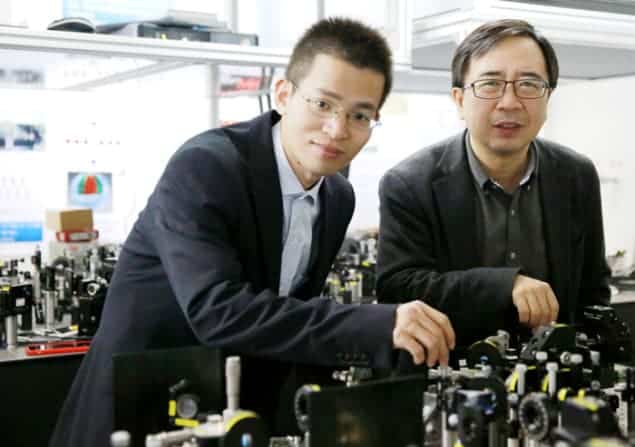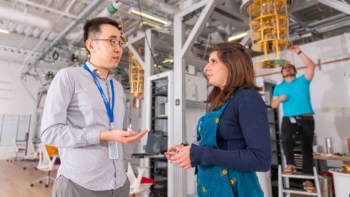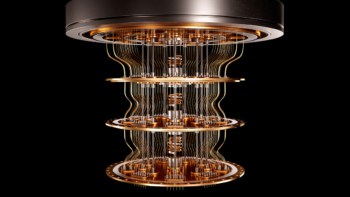With the Physics World 2019 Breakthrough of the Year due to be announced on 12 December, Physics World journalists look back at the past decade of winners and explore how research in that field has moved on. Here Tushna Commissariat reflects on the 2015 breakthrough, for simultaneously teleporting two quantum properties of a photon

In October 2013, Physics World celebrated its 25th anniversary. As part of our special issue, we picked five of the biggest and most significant discoveries in fundamental physics, made over the previous quarter century – one of which was quantum teleportation. It was no surprise then, that only two years later, our 2015 Breakthrough of the Year went to Jian-Wei Pan and Chaoyang Lu of the University of Science and Technology of China in Hefei, for being the first to achieve the simultaneous quantum teleportation of two inherent properties of a fundamental particle – the photon.
Teleportation has long been the stuff of fantasy and sci-fi, but science eventually caught up with fiction in 1993 when an international group of scientists said that quantum teleportation – the instantaneous transfer of a state between particles separated by a long distance – is entirely possible, so long as the original state is destroyed (thanks to the “no-cloning” theorem).
In the basic quantum teleportation protocol, an observer, Alice, sends information about an unknown quantum state to another observer, Bob, by exchanging classical information. To do this, a “quantum channel” must exist between the pair, which is created by giving both Alice and Bob are one half of an additional pair of entangled particles. Alice then interacts the unknown quantum state with her half of the entangled particle and measures the combined quantum state, before sending the result through a classical channel to Bob. The act of the measurement itself has already altered the state of Bob’s half of the entangled pair and this, combined with the result of Alice’s measurement, allows Bob to reconstruct the unknown quantum state, with no copies, and with the entanglement secure.
The first experimentation teleportation of the spin (or polarization) of a photon took place in 1997, and Pan was a part of this seminal research team, then under the tutelage Anton Zeilinger, his former PhD supervisor at the University of Vienna. Since their ground-breaking experiment, a whole host of various quantum proprieties, including atomic spin-states, nuclear spins, trapped ions and coherent light fields have all been teleported.

A decade of Physics World breakthroughs: 2009 – the first quantum computer
But all quantum particles (even simple ones such as the photon or the hydrogen atom) possess more than one inherent property or state (“multiple degrees of freedom”). So being able to teleport more than on of these at the same time would be a key step forward for any quantum communication protocol. Pan and colleagues’ 2015 award-winning experiment achieved precisely this, as they showed that they could reliably and repeatedly teleport a photon’s spin (polarization) and its orbital angular momentum (OAM) to another photon some distance away, at the same time. Their quantum channel in their protocol included a “hyper-entangled” set, where the two particles are simultaneously entangled in both their spin and their OAM.
There is an upper limit of three properties for this particular protocol, and Pan had told Physics World in 2015 that to achieve even that was a herculean feat as it requires the experimental ability to control 10 photons. “So far, our record is eight photon entanglement. We are currently working on two parallel lines to get more photon entanglement.”
Since then, Pan, Lu and colleagues have been rather busy with a whole host of amazing quantum feats, including launching the world’s first quantum satellite (2016) which exchanged quantum information between China and Austria; carrying out a teleportation experiment over 10kms in Hefei (2016); and even transmitting quantum data (to recreate an image) without the exchange of any particles (2017, this work featured on the Top 10 list of our 2017 Breakthroughs). Earlier this year, Pan and Lu’s team even showed that they can teleport multi-dimensional photon states (going beyond the 2D subspace of a qubit) – a follow-on to the 2015 work. The team reported the first quantum teleportation of what they call a qutrit, taking teleportation into 3D, a key step towards teleporting the entire quantum state of a particle. As Lu told Physics World, their scheme could be easily scaled up to go to four, five or more dimensions. Their team is now working on combining these higher dimensions with the multiple degrees of freedom, to try teleport complete particles.
You probably won’t be surprised to hear that Time magazine named Pan as one of its 100 Most Influential People of 2018 . Pan’s long-term goal is to set up a global quantum Internet, and at this rate, it won’t be that long before that too becomes a reality.



